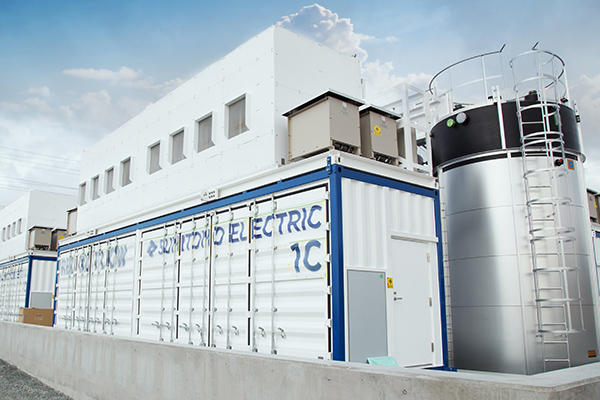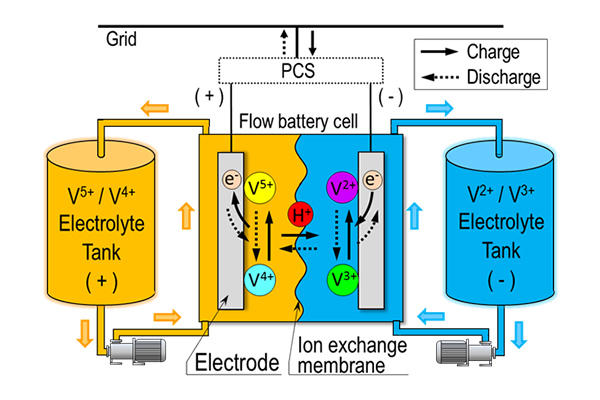Press Release
Initiating Redox Flow Batteries into the U.S. Wholesale Power Market
--Demonstrating the economic potential of storage batteries--
December 18, 2018
New Energy and Industrial Technology Development Organization
Sumitomo Electric Industries, Ltd.
The New Energy and Industrial Technology Development Organization (NEDO) and Sumitomo Electric Industries, Ltd. will connect a 2MW/8MWh stationary storage redox flow (RF) battery to the wholesale power market in California, USA. This demonstration is the first example of RF battery operation in the United States wholesale power market.
One important feature of the RF battery is that there are no restrictions on depth and number of charge/discharge cycles: one of many features making the RF battery suitable for long-lifetime large scale applications. The demonstration will examine techniques designed to enhance the economic value of RF batteries by providing frequency regulation and trade-based energy supply, which are central demands of the wholesale power market.

Fig.1. 2MW/8MWh Redox Flow Battery in California, USA
1. Overview
In California, U.S.A., the government has recently passed Senate Bill No. 100 declaring an ambitious policy stating that renewable energy and zero-carbon resources supply 100% of electricity consumed by California end-use customers and state agencies by 2045. Along with this trend, emerging problems include rapid changes in demand during morning and evening hours and declining power quality due to growth in photovoltaic power generation, thus adapting to these fluctuations is an urgent issue. As a solution, the state law AB 2514*1 obligates power companies to introduce storage battery facilities. In addition, a new program has been designed for the wholesale power market to ensure adequate revenues from storage batteries.
Against this backdrop, in September 2015, NEDO concluded a memorandum of understanding (MOU) with the California Governor's Office of Business and Economic Development (GO-Biz) in the United States. Under this agreement, a demonstration project was elected to promote the popularization of RF batteries*2 in San Diego, California, with the selection of Sumitomo Electric as a subcontractor.
This project*3 has three stages. In the first stage, which began in March 2017, NEDO and Sumitomo Electric, with cooperation from San Diego Gas & Electric Company (SDG&E), a major local power company, operated a 2 MW/8 MWh RF battery installed at a substation in an electricity distribution grid. In the composite mode of operation consisting of voltage regulation and excess power adaptation, among others, testing of the basic characteristics and reliability of the storage battery has been completed. Moreover, in cooperation with SDG&E, we have concurrently promoted technical work and clerical applications so as to connect the RF battery to the wholesale power market*4 set up by the California Independent System Operator (CAISO).
The application procedure for RF battery connection has recently been completed, allowing the project to proceed to the second stage: trading in the wholesale power market set up by CAISO.
This is the first entry of RF batteries into the wholesale power market in the United States.
2. Demonstration Project in Second Stage
CAISO is the organization that operates and controls the electricity transmission grid in California. Renewable energy has been increasingly introduced to its wholesale power market. This calls for supply capacity that provides long-period electrical energy [kilowatt hour (kWh)] to cope with energy supply time-shifts as well as adjusting capabilities that provide short-period output [kilowatt (kW)] such as frequency regulation.
Redox flow batteries feature restriction-free operation in terms of the depth of charge and discharge and the number of charge and discharge cycles. This implies that the RF battery is suitable for meeting charge and discharge requirements in two modes: short-period output and long-period electrical energy. Expectations are high for its adaptability to multi-purpose and flexible operation by outputting power to concurrently meet both short- and long-period fluctuation needs.
The second stage will take advantage of RF batteries to suitably test the potential of the most profitable operation techniques in specific hours and seasons by flexibly combining multiple trading schemes in the energy trading market and in the ancillary service market,*5 which provides frequency regulation and other services. Moreover, the project aims to achieve additional economic improvements by quickly adapting a new menu, currently in the program design phase, which is favorable for storage batteries. The testing of composite modes of storage battery operation techniques is the world's first attempt of this kind.

Fig.2. Conceptual illustration of the demonstration operation providing supply capacity and adjusting capabilities to the wholesale power market
3. Future Development
The third stage will start - composite operation in both electricity distribution and transmission grids. The operation techniques established in the first and second stages will be used to further enhance the economic value of RF batteries.
【 Notes 】
*1 State law AB 2514
Assembly Bill (AB) 2514 is a state law of California in the United States, which sets forth a policy to make it mandatory for power companies to complete the introduction of storage battery capacity up to a certain proportion by 2024.
*2 Redox flow (RF) battery
- Principle and Structure:
- An RF battery is a storage battery made up of a cell in which a battery reaction takes place, tanks that store active materials, and pumps and pipes used to circulate the active materials. Comprising independent blocks of output (kW) and capacity (kWh), RF batteries can be designed to exhibit suitable output and capacity performance for specific applications. Moreover, the RF battery is superb as a long-life and large-storage battery free from deterioration of electrodes and active materials because its charge and discharge reactions only involve changes in the valence states of ions in the electrolytes. Sumitomo Electric developed the system ahead of its competitors in the industry, selecting vanadium as the electrolytes.

Fig.3. Principle of redox flow battery
*3 This project
| Project Title | International Demonstration Project to Prove Japanese Technology for Improved Energy Consumption Efficiency/Demonstration Project Testing Storage Battery Operation for Both Electricity Transmission and Distribution in California, the United States. |
|---|---|
| Project Period | FY 2015 to FY 2020 |
| Subcontractor | Sumitomo Electric Industries, Ltd. |
*4 Wholesale power market
Operated by CAISO, the wholesale power market comprises the Day-Ahead Market and the Real-Time Market to procure electricity through bidding.
*5 Ancillary service market
System operators are obliged to maintain the frequency of the electric power system. They procure the power sources required for frequency regulation through contracts and markets. While the energy market supplies the required electricity, the ancillary service market provides regulation capability and reserve capacity to balance electricity supply and demand.


